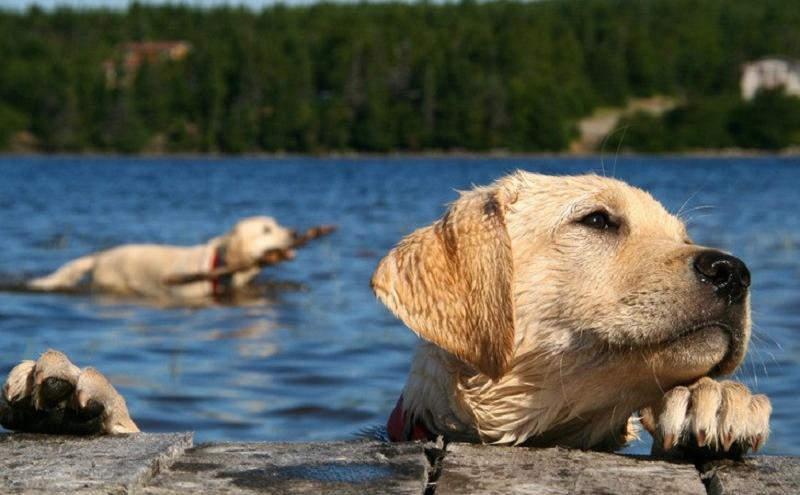
Outdoor Dog Bathing: What Every Pet Parent Should Know
Share
Bathing Your Dog Outdoors: Essential Tips for a Safe and Happy Splash
Swimming in lakes, rivers, or at the beach can be a fun and refreshing activity for your dog. But before letting your pup dive into the nearest pond, it’s important to understand the potential health risks, water safety precautions, and how to properly care for your dog’s coat afterward.
In this guide from Velvet Paw Blog, we’ll cover everything you need to know about outdoor bathing for dogs.

Swimming in Natural Waters: What Are the Health Risks?
While dogs love water, not all water is safe for them. Natural bodies of water can contain hazards that pose serious health risks:
- Bacteria and parasites: Standing water like ponds or lakes may harbor harmful bacteria (e.g., leptospirosis) and parasites that can make your dog sick.
- Saltwater: Ocean water can cause skin irritation and dryness if not rinsed off properly.
- Chemical runoff: Rivers near urban or industrial zones may carry toxic chemicals harmful to pets.
- Hidden objects: Sharp rocks, broken glass, or submerged debris can injure paws or cause cuts.
✅ Tip: Always inspect the water before allowing your dog to swim. Clear, moving water is generally safer than stagnant or murky pools.

How to Rinse Off Saltwater After a Beach Swim
Saltwater can dry out your dog’s skin and leave behind salt crystals in the coat. Proper rinsing is key to preventing irritation:
- Freshwater rinse: After a beach outing, rinse your dog thoroughly with clean, fresh water—pay special attention to paws, belly, and ears.
- Condition the coat: Use a moisturizing conditioner or leave-in spray to restore hydration, especially for long-haired breeds.
- Dry completely: Towel dry or use a pet-safe blow dryer to prevent hot spots or fungal infections.

Not All Water Is Safe: Where NOT to Let Your Dog Swim
Some natural waters pose more danger than fun. Here's where to be cautious:
- Still water: Ponds and bogs can contain algae blooms, parasites, or bacteria dangerous to dogs.
- Polluted rivers: Urban waterways may be contaminated with industrial waste, detergents, or chemicals.
- Cold water: Swimming in icy lakes or rivers can lead to hypothermia, especially for short-haired or small breeds.
✅ Tip: Avoid waters with visible algae, foul smells, excessive debris, or foam. If in doubt—don’t let your dog in.
Eco-Friendly Grooming Tips for Outdoor Adventures
Bathing your dog outdoors? Choose nature-safe products to protect your pet and the planet:
- Biodegradable shampoos: Opt for formulas labeled eco-friendly or biodegradable. These won’t harm local ecosystems or wildlife.
- Gentle ingredients: Natural shampoos with aloe vera, oatmeal, or chamomile soothe skin without harsh chemicals.
- Safe application: Keep shampoo away from your dog’s eyes and ears to avoid irritation or infection.
✅ Tip: Don’t bathe your dog directly in lakes or streams—lather and rinse at least 50 feet away from the water source.

Aftercare: Don’t Skip the Post-Swim Routine
Even if your dog looks clean, water play can leave residue, bacteria, or irritants in the coat. Here's how to wrap up the perfect outdoor swim:
- Check your dog’s coat for debris, ticks, or matting.
- Brush thoroughly to prevent tangles, especially in long-haired breeds.
- Watch for signs of irritation or infection in the skin, ears, or paws.
- Consider a visit to a groomer after a muddy or sandy swim day.
Conclusion: Let Your Dog Enjoy Nature—Safely
Outdoor bathing and swimming can bring your dog joy, exercise, and bonding time. But it’s crucial to ensure that the experience is safe, clean, and comfortable.
With the right precautions and post-swim care, you can let your pup explore the wild without risking their health. And if you're unsure about your dog’s skin condition or hygiene needs after an outdoor adventure, don’t hesitate to consult a vet or professional groomer.
Nature is a playground—but your pet’s health comes first.
